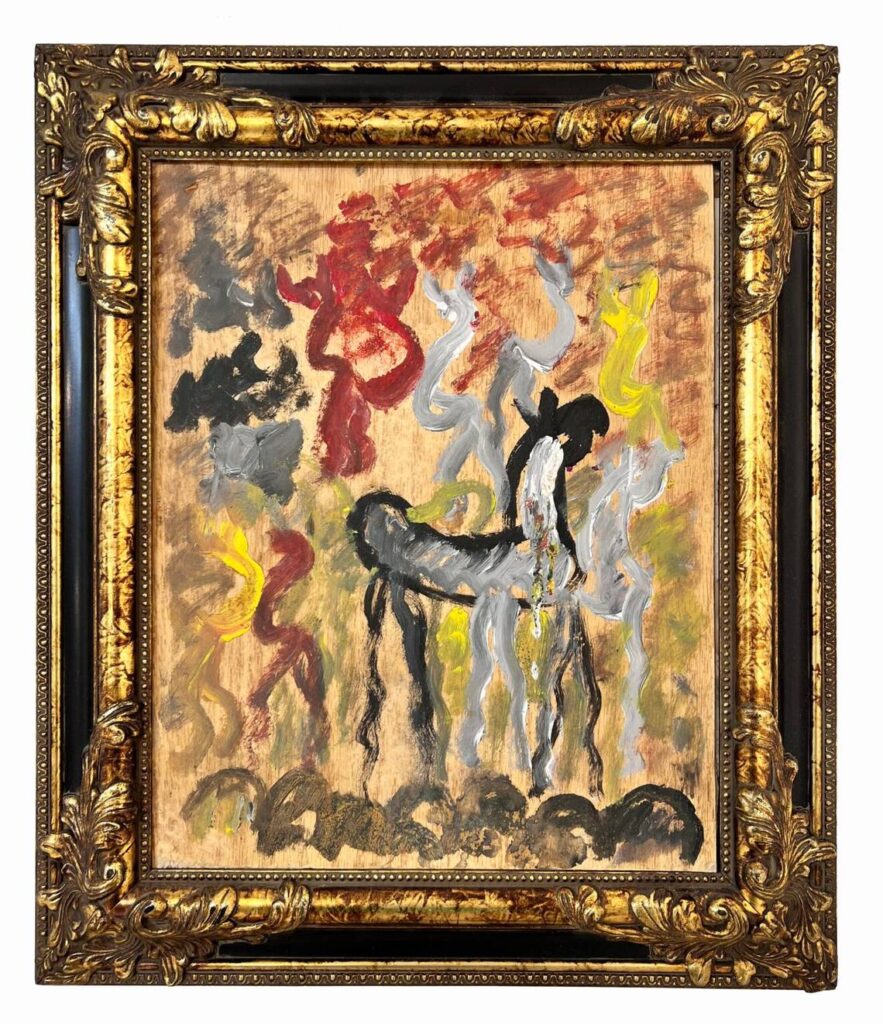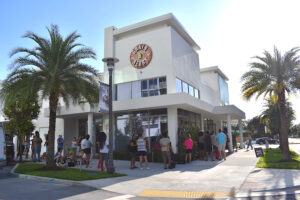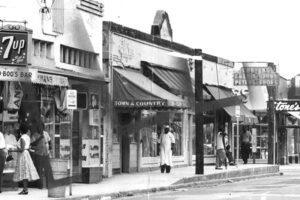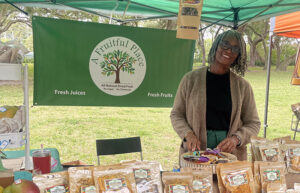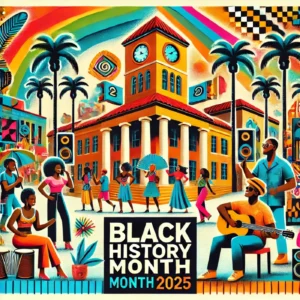By Miguel Sirgado Artburst Miami
It has been said and often that Purvis Young is to Overtown what Jean-Michel Basquiat and Keith Haring were to Lower Manhattan. Young’s work draws deeply from the elements around him—in his surroundings, through street graffiti, and at his studio in a mostly African-American neighborhood of Miami—organically blending painting, drawing, and collage materials.
“For many years, people have called me all sorts of things to describe me as an outcast artist, a Black artist, a ghetto artist, the Picasso of the ghetto,” Young said in an interview for a publication for the Art Museum of DeLand, which in 2020 organized a retrospective. “I just want to be called an artist. The only thing I’ve done all my life is paint,” said the visionary, self-taught American artist of Bahamian descent.
Since his death at the age of 67 in April 2010, Young’s work remains relevant. His tremendous ability to create an intense “visual narrative” defines the context and history of his community, its struggles, its resistance and its spirit of resilience.
Pan American Art Projects gallery is showing “Purvis Young: A Vision of Miami’s Cultural Identity,” an exhibition that pays tribute to the extraordinary legacy of Young. Curator Claudia Taboada’s selection includes rarely seen works, which will be on view opening Saturday, Feb. 1 through Saturday, March 22, at the gallery’s Little River location.
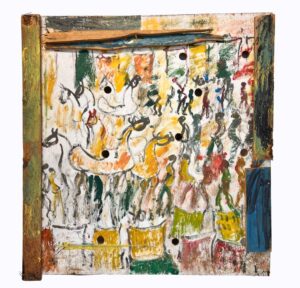
“The idea for this exhibition came from a desire to pay tribute to Purvis Young, who not only transformed Miami’s art scene, but also captured the spirit and cultural identity of the city through his work,” says Taboada, curator of the show and director of Pan American Art Projects. “Luckily we were able to bring together a selection of pieces that had only been shown once before: some in Art Miami’s ‘Wall of Peace’ in 2007, or the ‘Paintings from the Street’ retrospective exhibition at the Boca Raton Museum in 2006,” she says. In addition to celebrating his work, the curator believes that the show essentially invites the public to reflect on the social and cultural dynamics that inspired him—and how these themes remain relevant in a global context—which undoubtedly makes the work transcend its temporality. “What I admire most about Purvis Young is his ability to turn everyday and found materials into powerful visual content that reflected a profound critique of his reality. Aware that his voice represented his community, he took it upon himself to question racial segregation and the marginalization of women through his work,” says Taboada.
One of the most significant accomplishments of the artist’s legacy was his role in transforming the perception of street art, redefining its value and elevating it—even in contrast to what some in his time regarded as primitivist art. “The art world no longer isolates self-taught creators like Young with labels like ‘outsider’ or ‘naif.’ Today, Young’s spontaneous gestural reveries, painted on found surfaces, are discussed in the same terms and with the same respect for their intellectual content as the works of other artists, in the same terms and with the same respect for their neo-expressionist intellectual content,” says Adrienne Von Lates, a curator, scholar, and art advisor with Master’s and Ph.D. degrees in Art History from Columbia University; Von Lates has also served as curator and director of education at MOCA North Miami and the Bass Museum of Art. She is also an adjunct faculty member at the College of Communication, Architecture, and The Arts at FIU.
The exhibition at Pan American Art Projects, which features some twenty works from the collection of Martin Siskind—a close friend of the artist and custodian of a significant archive of his work—highlights Young’s inexhaustible creativity and unique ability to work with multiple expressive media simultaneously.
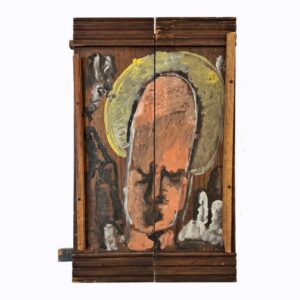
The artist used techniques such as painting, assemblage, and works made from paper and recycled materials. “These pieces reflect his unique approach of taking advantage of whatever was available to him to create art, from doors and reclaimed wood to everyday objects such as lace, grilles, political banners, magazines and books, among others,” explains Taboada. According to the curator, the organization of the space and the dialogue between the pieces was based on first recreating elements of Young’s creative environment. His Overtown studio (adorned with posters of his exhibitions), his ladder and lamp for painting, are all accompanied by audiovisual materials. “The works were grouped by main themes (spirituality, social protest, everyday life) to highlight the connections between them and create a coherent narrative,” says Taboada. “This arrangement allows the pieces to dialogue with each other, showing how the local issues that Purvis addressed connect to universal concerns. The exhibition is centered around the work “Guardian Angel.”
“It is surrounded by the allegory of the Virgen de la Caridad del Cobre, his Overtown neighborhood, the recurring figure of the pregnant woman and the horses that represent freedom,” explains the curator. The exhibition not only highlights the significance of Young’s work but also serves as a testament to the unwavering dedication of Siskind, who supported his friend for over 20 years. “Martin kept Young’s creative fire going by making sure he had a pacemaker, a corneal transplant, dialysis and diabetes treatments, and a new kidney,” explains Von Lates. The scholar says that from his early years exhibiting hundreds of small paintings in Goodbread Alley, Young’s ambition was to share his work with as many people as possible.
“His images were crying out to be savored by a large audience, not locked up in a warehouse,” says Von Lates.
Most of the works in the exhibition have not been seen by the public since Young made them and entrusted them to Siskind, whose home has become a shrine to the artist, according to Von Lates. “Visitors to this exhibition will be beguiled by images that look as fresh as the day they were painted. They remain forever ‘Young,’ ” she concludes. Young’s show is accompanied by a collaborative exhibition titled “Voices from the Edge,” which explores unfiltered creativity and the intersection between mental health and art. The parallel exhibit features works by Candice Avery, Jorge Alberto Cadí, Isaac Crespo, Sebastián Ferreira, Jorge A. Hernández, Ramón Llosa, Echo McCallister, Milton Schwartz, Carlos Stella and Misleidys Castillo, all artists whose creations have been shaped by their battles with mental illness.
If you go:
WHAT: “Purvis Young: A Visionary of Miami’s Cultural Identity”
WHEN: Opens Saturday, Feb. 1 through Saturday, March 22. Hours: 11 a.m. to 5 p.m., Tuesday through Saturday.
WHERE: Pan American Art Projects, 274 NE 67th St., Miami COST: Free
Read more at: https://www.miamiherald.com/entertainment/visual-arts/article299390684.html#storylink=cpy

